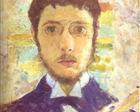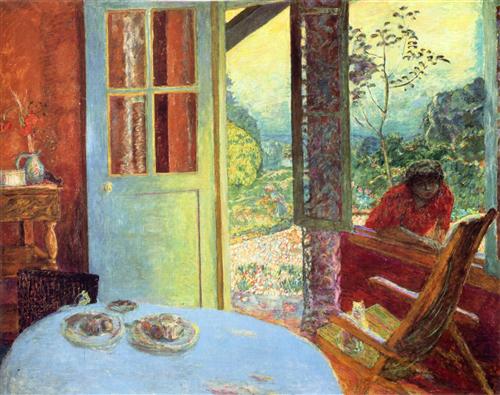
Synopsis
Pierre Bonnard was a member of the Symbolist group of painters known as Les Nabis(“prophets” or “seers”), and so subscribed to the Nabi doctrine of abandoning three-dimensional modeling in favor of flat color areas. However, although Bonnard was a member of this group, he was not interested in obscure Symbolist subject matter and was not a mystic. Instead, he was satisfied – even fascinated and delighted by – the scenes of simple daily life around him. Because of this, he has been called an “intimist.”
Key Ideas
For Bonnard, color was an end in itself – a way of experiencing the world. Color was so important to Bonnard that when he had mixed a color that was particularly to his liking, he would even go back and touch up other paintings with that color. He once persuaded his friend Édouard Vuillard to distract one of the guards in a museum while he touched up a work that had been completed years previously.
Bonnard painted many of his scenes from memory, capturing the spirit of the moment rather than the exact person or place. Bonnard did not paint from life but rather drew his subjects – sometimes photographing them as well – and made notes on the colors. He then painted – and especially, colored – the canvas in his studio from his notes.
Bonnard also designed furniture, developed textile patterns, painted screens, created stage sets, made puppets for puppet shows, and illustrated books. Though he is most noted for his paintings, these additional activities also situate him squarely within that part of Nabi art that applied their aesthetic to other art forms; this aspect of his practice reflects both that period’s interest in the decorative as a way to unify the environment through largely abstract means and artists’ interest in serving the needs of public spaces, including the burgeoning field of advertising.
Most Important Art
Dining Room in the Country (1913)

Bonnard was fascinated with different levels of perspective and with the tricks of perspective. In this painting there are no real space-defining objects – the chair and the washstand blend into the wall. The composition is a “corner composition,” moving diagonally across the table, treated as a vertical plane, through the doorway to the woman to the landscape. Then there is a cross-diagonal movement through the chair to the washstand. This spatial movement is largely dependent on color; color is the primary director of this painting. Our eye is carried from the indoors to the outdoors via the red color. The door is the same color as the landscape, the table, and the crockery. Bonnard also contrasts the warm orange-red colors of the interior and the cool whites of the outdoors – a contrast accompanied by a heightened quality of the light.
Typically, Bonnard’s figures appear less psychologically complex than the figures of Vuillard. As in this painting, the figure seems withdrawn – functioning as a mere prop – and is, in fact, psychologically recessive. That she seems to lack tangibility and psychological presence is borne out of the fact that although she is outdoors, the artist has placed her within a shadow and painted her in the same color as the interior wall. Bonnard is less interested in the specificity of the person, and instead, sets up a very complex spatial organization emphasizing that which is indoors and that which is outdoors, thus heightening Impressionist color and harnessing it to the service of linking figure to environment rather than recording a specific time of day. As is characteristic of the artist’s work, the emphasis is on embedding the figure into the sensuous environment of both the depicted scene and the painted reality.
More Art Works

